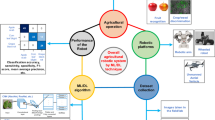Abstract
The methods used to protect agricultural products currently undergo drastic changes. Artificial Intelligence is a prime candidate to overcome two challenges faced by farmers around the world: The increasing cost and decreasing availability of human labor for weed control, and the growing global restriction of herbicides. Deep Learning is one of the most prominent approaches for applying AI to all kinds of use cases in industrial applications, entertainment, and security. Its latest field of application is plant classification that enables automated weed control and precise spot spraying of herbicides. While cheap, powerful platforms for deploying classification mechanisms are widely available, this comes at the cost of expensive and effort rich classifier training. This effectively makes Deep Learning-based approaches unavailable for the majority of the agricultural sector. Deepfield Robotics presents a systematic approach for deploying AI onto fields at large, including the learnings that led to their self-contained AI driven plant classification modules that relieve individuals from having to deploy their own AI solution. The same technology acts as enabler for more agricultural domains, such as targeted fertilization, nano irrigation, and automated phenotyping. This article documents Deepfield Robotics’ findings and vision on how AI can be the workhorse for agricultural weeding labor.







Similar content being viewed by others
References
Union of concerned scientists. The rise of superweeds—and What to do about it. 2013. https://www.ucsusa.org/sites/default/files/legacy/assets/documents/food_and_agriculture/rise-of-superweeds.pdf. Accessed 20 Aug 2019
Hedlund B, Goldman A (2019) Where is Glyphosate Banned? https://www.baumhedlundlaw.com/toxic-tort-law/monsanto-roundup-lawsuit/where-is-glyphosate-banned/. Accessed 20 Aug 2019
Lottes P, Behley J, Milioto A, Stachniss C (2018) Fully convolutional networks with sequential information for robust crop and weed detection in precision farming. https://arxiv.org/pdf/1806.03412.pdf
Lottes P, Behley J, Chebrolu N, Milioto A, Stachniss C (2018) Joint stem detection and crop-weed classification for plant-specific treatment in precision farming. https://arxiv.org/pdf/1806.03413.pdf
Milioto A, Lottes P, Stachniss C (2017) Real-time blob-wise sugar beets vs weed classification for monitoring fields using convolutional neural networks. https://www.isprs-ann-photogramm-remote-sens-spatial-inf-sci.net/IV-2-W3/41/2017/isprs-annals-IV-2-W3-41-2017.pdf. Accessed 20 Aug 2019
Ruckelshausen A, Biber P, Dorna M, Gremmes H, Klose R, Linz A, Rahe F, Resch R, Thiel M, Trautz D, Weiss U (2009) BoniRob: an autonomous field robot platform for individual plant phenotyping. https://www.hs-osnabrueck.de/fileadmin/HSOS/Homepages/COALA/Veroeffentlichungen/2009-JIAC-BoniRob.pdf. Accessed 20 Aug 2019
Xie S, Girshick R, Dollár P, Tu Z, He K (2017) Aggregated residual transformations for deep neural networks. In: Proceedings of the IEEE conference on computer vision and pattern recognition. pp 1492–1500
Huang G, Liu Z, Van Der Maaten L, Weinberger KQ (2017) Densely connected convolutional networks. In: Proceedings of the IEEE conference on computer vision and pattern recognition. pp 4700–4708
Long J, Shelhamer E, Darrell T (2015) Fully convolutional networks for semantic segmentation. In: Proceedings of the IEEE conference on computer vision and pattern recognition. 3431–3440
Ronneberger O, Fischer P, Brox T (2015) U-net: Convolutional networks for biomedical image segmentation. International conference on Medical image computing and computer-assisted intervention. pp 234–241
Jégou S, Drozdzal M, Vazquez D, Romero A, Bengio Y (2017) The one hundred layers tiramisu: fully convolutional densenets for semantic segmentation. In: Proceedings of the IEEE conference on computer vision and pattern recognition workshops. pp 11–19
Author information
Authors and Affiliations
Corresponding author
Ethics declarations
Conflict of interest
The authors declare that they have no conflict of interest.
Rights and permissions
About this article
Cite this article
Amend, S., Brandt, D., Di Marco, D. et al. Weed Management of the Future. Künstl Intell 33, 411–415 (2019). https://doi.org/10.1007/s13218-019-00617-x
Received:
Accepted:
Published:
Issue Date:
DOI: https://doi.org/10.1007/s13218-019-00617-x




